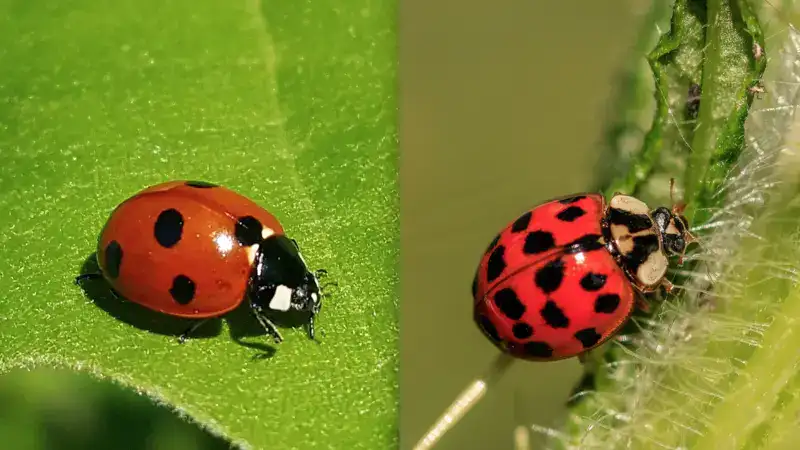Table of Contents
ToggleIntroduction to the Asian Lady Beetle
The Asian lady beetle, also known as Harmonia axyridis, is a species of ladybug native to Asia. While beneficial for controlling agricultural pests, these beetles have become a nuisance in many parts of North America and Europe. Understanding their behavior and the potential for bites is essential for managing their impact.
What is an Asian Lady Beetle?
Origin and Spread
The Asian lady beetle was introduced to North America in the 20th century to control aphids and other pests. Since then, they have spread widely and are now common in many regions. They are recognizable by their varying colors, ranging from yellow to red, and their distinctive black spots.
Beneficial Role
Asian lady beetles play a beneficial role in agriculture by preying on pests that damage crops. Farmers appreciate their help in reducing the need for chemical pesticides. However, their tendency to enter homes in large numbers during the fall can make them unwelcome guests.
Asian Lady Beetle Bite: Myth or Reality?
Can Asian Lady Beetles Bite?
Yes, Asian lady beetles can bite. Although they are not aggressive, they may bite if they feel threatened or if they land on human skin and mistake it for food. Their bites are not venomous but can be irritating.
Identifying a Bite
An Asian lady beetle bite feels like a pinprick. The bite may cause minor discomfort and, in some cases, a small red mark. While the bite itself is not harmful, some individuals may experience an allergic reaction.
Symptoms and Reactions
Common Symptoms
Most people experience mild symptoms from an Asian lady beetle bite, including:
- A sharp, pinprick sensation
- A small red mark at the site of the bite
- Mild itching or irritation
Allergic Reactions
In rare cases, individuals may have an allergic reaction to the bite. Symptoms of an allergic reaction can include:
- Swelling and redness around the bite area
- Itching or hives
- Respiratory issues such as wheezing or shortness of breath If you experience any severe symptoms, seek medical attention immediately.
Preventing Asian Lady Beetle Bites
Keep Them Out of Your Home
Preventing Asian lady beetles from entering your home is the best way to avoid bites. Here are some tips:
- Seal cracks and gaps around windows, doors, and foundations
- Install screens on windows and vents
- Use weather stripping around doors and windows
Natural Repellents
Using natural repellents can also help keep Asian lady beetles at bay. Essential oils like citronella, eucalyptus, and tea tree oil are effective. Mix a few drops with water and spray around entry points to deter these beetles.
Avoiding Direct Contact
If you encounter Asian lady beetles, avoid handling them directly. Use a vacuum or a broom to remove them from your living space. Wearing gloves can also protect your skin if you need to handle them.
What to Do if You Are Bitten
Immediate Actions
If you are bitten by an Asian lady beetle, wash the affected area with soap and water to prevent infection. Apply a cold compress to reduce swelling and ease discomfort. Over-the-counter antihistamines or hydrocortisone cream can help alleviate itching and irritation.
When to Seek Medical Attention
Most bites do not require medical attention. However, if you experience severe symptoms such as difficulty breathing, significant swelling, or a rash, seek medical help immediately. These could be signs of a serious allergic reaction.
Dealing with Infestations
Professional Pest Control
If you have a large infestation of Asian lady beetles in your home, consider hiring a professional pest control service. They can safely and effectively remove the beetles and prevent future infestations.
DIY Solutions
For minor infestations, there are several do-it-yourself solutions. Using a vacuum cleaner to remove beetles is a common method. Be sure to empty the vacuum bag outside to prevent them from re-entering your home. Sticky traps and light traps can also be effective in capturing these beetles.
Understanding Their Behavior
Seasonal Patterns
Asian lady beetles are most active in the fall when they seek shelter from the cold. They often enter homes through small cracks and crevices. Understanding their seasonal behavior can help you prepare and prevent infestations.
Attractants
These beetles are attracted to light-colored buildings and homes with sunny exposures. Reducing outdoor lighting and using dark curtains can help minimize their attraction to your home. Additionally, eliminating food sources such as aphids from your garden can reduce their presence.
Benefits and Drawbacks
Agricultural Benefits
Despite their nuisance factor, Asian lady beetles provide significant benefits in agriculture. Their predation on harmful pests helps protect crops and reduce the need for chemical pesticides. Farmers value their role in maintaining healthy crops and reducing pest populations.
Household Nuisance
However, their tendency to invade homes in large numbers during the fall makes them a household nuisance. Their presence can be overwhelming, and their bites, while not harmful, add to the discomfort. Managing their population and preventing infestations is essential for maintaining a comfortable living environment.
Conclusion
Asian lady beetles, while beneficial in agriculture, can become a nuisance when they invade homes and bite. Understanding their behavior and taking preventive measures can help you avoid bites and manage infestations effectively. By sealing entry points, using natural repellents, and being cautious around these beetles, you can minimize their impact on your home. If bitten, simple first aid measures usually suffice, but be aware of potential allergic reactions. With these strategies, you can coexist with Asian lady beetles while enjoying the benefits they bring to agriculture.
